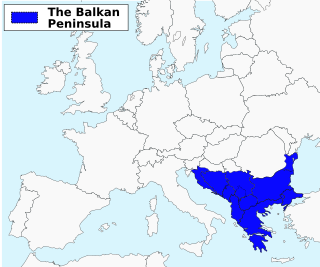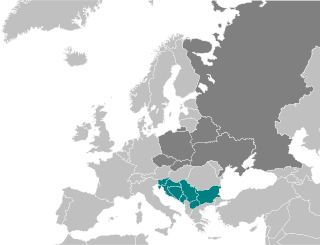
Dubrovnik, historically known as Ragusa, is a city on the Adriatic Sea in the region of Dalmatia, in southern Croatia. It is one of the most prominent tourist destinations in the Mediterranean Sea, a seaport and the centre of Dubrovnik-Neretva County. Situated in an exclave, it is connected to the rest of the country by the Pelješac Bridge. Its total population is 42,615. In 1979, the city of Dubrovnik was added to the UNESCO list of World Heritage Sites in recognition of its outstanding medieval architecture and fortified old town.

In classical antiquity, Illyria was a region in the western part of the Balkan Peninsula inhabited by numerous tribes of people collectively known as the Illyrians. Illyrians spoke the Illyrian language, an Indo-European language, which in ancient times perhaps also had speakers in some parts of Southern Italy. The geographical term Illyris was sometimes used to define approximately the area of northern and central Albania down to the Aoös valley, including in most periods much of the lakeland area. In Roman times the terms Illyria / Illyris / Illyricum were extended from the territory that was roughly located in the area of the south-eastern Adriatic coast and its hinterland, to a broader region stretching between the Adriatic Sea and the Danube, and from the upper reaches of the Adriatic down to the Ardiaei. From about mid 1st century BC the term Illyricum was used by the Romans for the province of the Empire that stretched along the eastern Adriatic coast north of the Drin river, south of which the Roman province of Macedonia began.
Illyrian may refer to:

Nikšić, is the second largest city in Montenegro, with a total population of 56,970 located in the west of the country, in the centre of the spacious Nikšić field at the foot of Trebjesa Hill. It is the center of Nikšić Municipality with population of 72,443 according to 2011 census, which is the largest municipality by area and second most inhabited after Podgorica. It was also the largest municipality by area in the former Yugoslavia. It is an important industrial, cultural, and educational center.

The Bay of Kotor, also known as the Boka, is a winding bay of the Adriatic Sea in southwestern Montenegro and the region of Montenegro concentrated around the bay. It is also the southernmost part of the historical region of Dalmatia. The bay has been inhabited since antiquity. Its well-preserved medieval towns of Kotor, Risan, Tivat, Perast, Prčanj and Herceg Novi, along with their natural surroundings, are major tourist attractions. The Natural and Culturo-Historical Region of Kotor was designated a UNESCO World Heritage Site in 1979. Its numerous Orthodox and Catholic churches and monasteries attract numerous religious pilgrims and other visitors.
The Illyrians were a group of Indo-European speaking peoples, who inhabited the western Balkan Peninsula in ancient times. They constituted one of the three main Paleo-Balkan populations, along with the Thracians and Greeks.

Duklja was a medieval South Slavic state which roughly encompassed the territories of modern-day southeastern Montenegro, from the Bay of Kotor in the west to the Bojana River in the east, and to the sources of the Zeta and Morača rivers in the north. First mentioned in 10th– and 11th century Byzantine chronicles, it was a vassal of the Bulgarian Empire between 997 and 1018, and then of the Byzantine Empire until it became independent in 1040 under Stefan Vojislav who rose up and managed to take over territories of the earlier Serbian Principality, founding the Vojislavljević dynasty. Between 1043 and 1080, under Mihailo Vojislavljević, and his son, Constantine Bodin, Duklja saw its apogee. Mihailo was given the nominal title King of Slavs by the Pope after having left the Byzantine camp and supported an uprising in the Balkans, in which his son Bodin played a central part. Having incorporated the Serbian hinterland and installed vassal rulers there, this maritime principality emerged as the most powerful Serb polity, seen in the titles used by its rulers. However, its rise was short-lived, as Bodin was defeated by the Byzantines and imprisoned; pushed to the background, his relative and vassal Vukan became independent in Raška, which continued the fight against the Byzantines while Duklja was struck with civil wars. Between 1113 and 1149 Duklja was the centre of Serbian–Byzantine conflict, with members of the Vojislavljević as protégés of either fighting each other for power. Duklja was then incorporated as a crown land of the Grand Principality of Serbia ruled by the Vukanović dynasty, subsequently known as Zeta, remaining so until the fall of the Serbian Empire in the 14th century.

The Balkans and parts of this area are alternatively situated in Southeast, Southern, Eastern Europe and Central Europe. The distinct identity and fragmentation of the Balkans owes much to its common and often turbulent history regarding centuries of Ottoman conquest and to its very mountainous geography.

Travunia was a South Slavic medieval principality that was part of Medieval Serbia (850–1371), and later the Medieval Bosnia (1373–1482). The principality became hereditary in a number of noble houses, often kin to the ruling dynasty. The region came under Ottoman rule in 1482. Its seat was in the city of Trebinje.

Orjen is transboundary Dinaric Mediterranean limestone mountain range, located between southernmost Bosnia and Herzegovina and southwestern Montenegro.
The Delmatae, alternatively Dalmatae during the Roman period, were a group of Illyrian tribes in Dalmatia, contemporary southern Croatia and western Bosnia and Herzegovina. The region of Dalmatia takes its name from the tribe.
The History of Dalmatia concerns the history of the area that covers eastern coast of the Adriatic Sea and its inland regions, from the 2nd century BC up to the present day.
Francesco Maria Appendini was an Italian Latin and Italian scholar who studied Slavic languages in the Republic of Ragusa. The French invasion prevented him from returning to Italy, and he adopted Republic of Ragusa as his own country. He took it upon himself to investigate its history and antiquities.

South Slavs are Slavic peoples who speak South Slavic languages and inhabit a contiguous region of Southeast Europe comprising the eastern Alps and the Balkan Peninsula. Geographically separated from the West Slavs and East Slavs by Austria, Hungary, Romania, and the Black Sea, the South Slavs today include Bosniaks, Bulgarians, Croats, Macedonians, Montenegrins, Serbs, and Slovenes, respectively the main populations of Bosnia and Herzegovina, Bulgaria, Croatia, North Macedonia, Montenegro, Serbia, and Slovenia.

Glamoč is a town and municipality located in Canton 10 of the Federation of Bosnia and Herzegovina, an entity of Bosnia and Herzegovina. It is situated in southwestern Bosnia and Herzegovina, at the foothills of Staretina and Velika Golija mountains, and on the edge of the central part of the Glamoč Field. The municipality encompasses the town of Glamoč as a seat of the municipality and more than 50 villages and hamlets situated along the Field. It mainly covers an area of the historical and geographical region of Tropolje.

Within the boundaries of today's Bosnia and Herzegovina, there have been many layers of prehistoric cultures whose creation and disappearance are linked to migrations of unidentified ethnic groups.
The Ardiaei were an Illyrian people residing on territory of present-day Albania, Kosovo, Montenegro, Bosnia and Herzegovina and Croatia between Adriatic coast on the south, Konjic on the north, along the Neretva river and its right bank on the west, extending to Lake Shkodra to the southeast. From the 3rd century BC to 168 BC the capital cities of the Ardiaean State were Rhizon and Scodra.

Delminium was an Illyrian city and the capital of the Dalmatia which was located somewhere near today's Tomislavgrad, Bosnia and Herzegovina, under which name it also was the seat of a Latin bishopric.
Events from the 9th century in, or regarding, Historic Serbia or Serbs.
Italians of Croatia are an autochthonous historical national minority recognized by the Constitution of Croatia. As such, they elect a special representative to the Croatian Parliament. There is Italian Union of Croatia and Slovenia, in Croat Talijanska Unija, in Slovene Italijanska Unija, which is Croat-Slovene organization with main site in Fiume-Rijeka and secondary site in Capodistria-Koper of Slovenia.